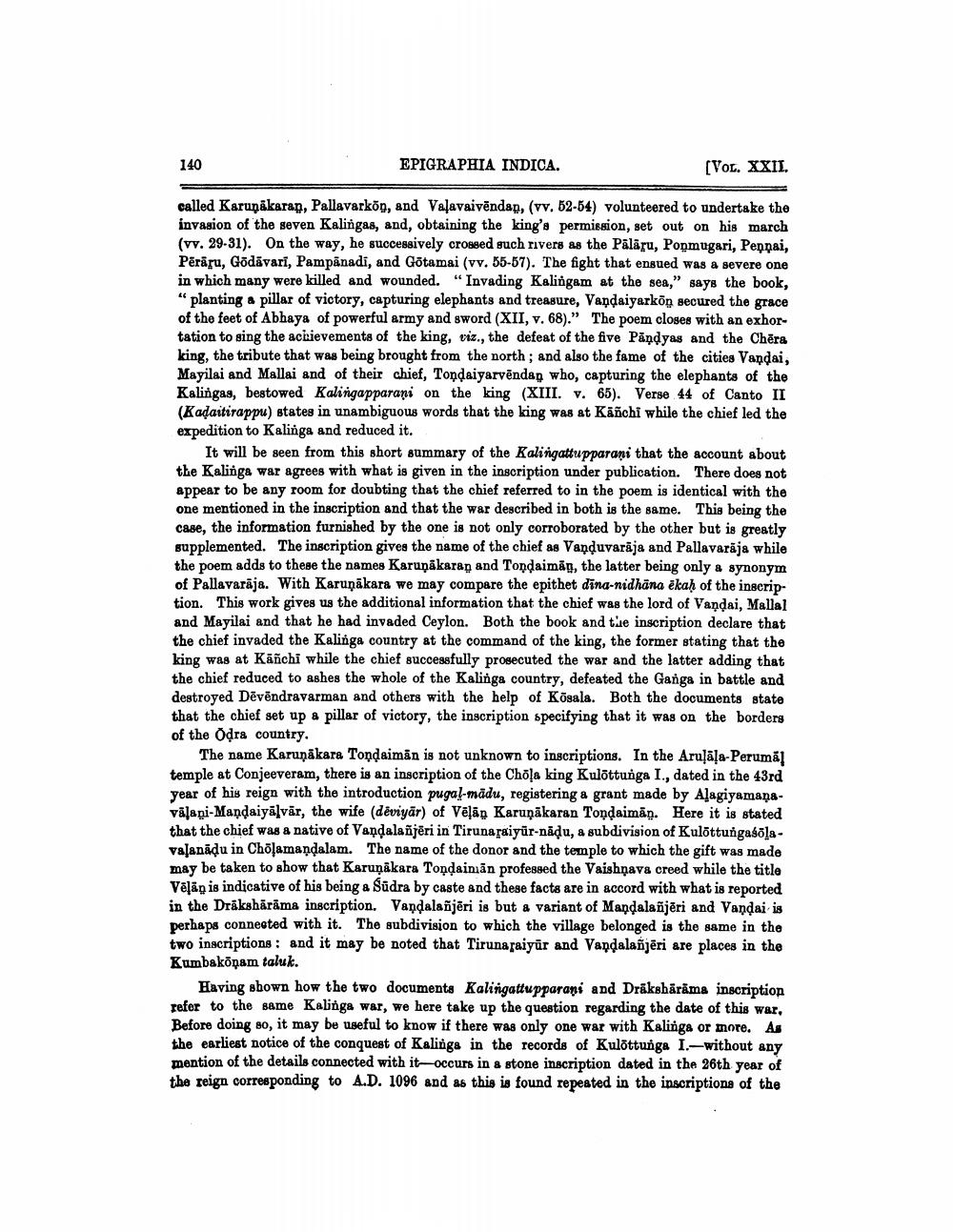________________
140
EPIGRAPHIA INDICA.
[VOL. XXII.
called Karunākaran, Pallavarkon, and Valavaivēndan, (vv. 52-54) volunteered to undertake the invasion of the seven Kalingas, and, obtaining the king's permission, set out on his march (vv. 29-31). On the way, he successively crossed such rivers as the Pālāru, Popmugari, Peņņai, Pērāru, Gödāvari, Pampanadi, and Götamai (vv. 55-57). The fight that ensued was a severe one in which many were killed and wounded. "Invading Kalingam at the sea," says the book, “planting a pillar of victory, capturing elephants and treasure, Vandaiyarköp secured the grace of the feet of Abhaya of powerful army and sword (XII, v. 68)." The poem closes with an exhortation to sing the achievements of the king, viz., the defeat of the five Påndyas and the Chēra king, the tribute that was being brought from the north ; and also the fame of the cities Vandai, Mayilai and Mallai and of their chief, Tondaiyarvēndan who, capturing the elephants of the Kalingas, bestowed Kalingapparani on the king (XIII. v. 65). Verse 44 of Canto II (Kadaitirappu) states in unambiguous words that the king was at Käñchi while the chief led the expedition to Kalinga and reduced it.
It will be seen from this short summary of the Kalingattupparani that the account about the Kalinga war agrees with what is given in the inscription under publication. There does not appear to be any room for doubting that the chief referred to in the poem is identical with the one mentioned in the inscription and that the war described in both is the same. This being the case, the information furnished by the one is not only corroborated by the other but is greatly supplemented. The inscription gives the name of the chief as Vanduvarāja and Pallavarāja while the poem adds to these the names Karunakaran and Tondaimág, the latter being only a synonym of Pallavarāja. With Karunākara we may compare the epithet dina-nidhāna ēkah of the inscription. This work gives us the additional information that the chief was the lord of Vandai, Mallal and Mayilai and that he had invaded Ceylon. Both the book and the inscription declare that the chief invaded the Kalinga country at the command of the king, the former stating that the king was at Kāñchi while the chief successfully prosecuted the war and the latter adding that the chief reduced to ashes the whole of the Kalinga country, defeated the Ganga in battle and destroyed Dēvēndravarman and others with the help of Kösala. Both the documents state that the chief set up a pillar of victory, the inscription specifying that it was on the borders of the Odra country.
The name Karuņākara Tondaimán is not unknown to inscriptions. In the Arulāla-Perumal temple at Conjeeveram, there is an inscription of the Chola king Kulõttunga I., dated in the 43rd year of his reign with the introduction pugal-mādu, registering a grant made by Alagiyamanavālapi-Mandaiyā vār, the wife (dēviyār) of Vēļā Karunākaran Tondaimán. Here it is stated that the chief was a native of Vandalañjēri in Tirunafaiyūr-nādu, a subdivision of Kulottungasolavalanādu in Chöļamandalam. The name of the donor and the temple to which the gift was made may be taken to show that Karuņākara Toņdainiān professed the Vaishnava creed while the title Vēļān is indicative of his being a Sūdra by caste and these facts are in accord with what is reported in the Drakshäräma inscription. Vandalañjēri is but a variant of Mandalañjēri and Vandai is perhaps connected with it. The subdivision to which the village belonged is the same in the two inscriptions and it may be noted that Tirunaraiyur and Vandalañjēri are places in the Kumbakonam taluk.
Having shown how the two documents Kalingattupparani and Drākshärama inscription refer to the same Kalinga war, we here take up the question regarding the date of this war, Before doing so, it may be useful to know if there was only one war with Kalinga or more. As the earliest notice of the conquest of Kalinga in the records of Kulõttunga I.-without any mention of the details connected with it occurs in & stone inscription dated in the 26th year of the reign corresponding to A.D. 1096 and as this is found repeated in the inscriptions of the




